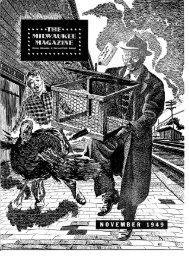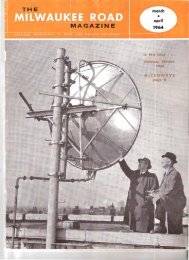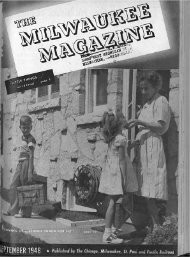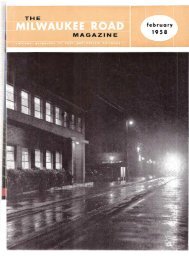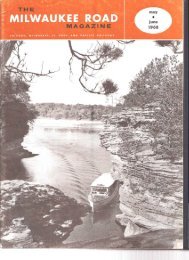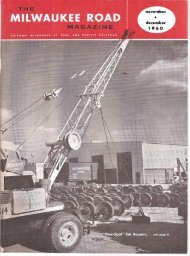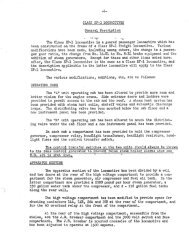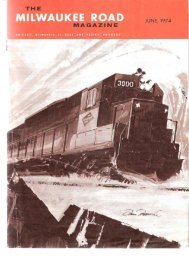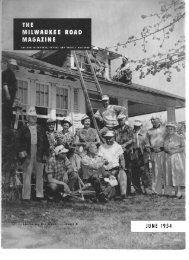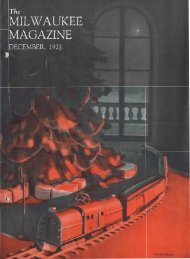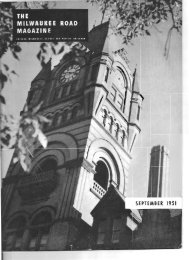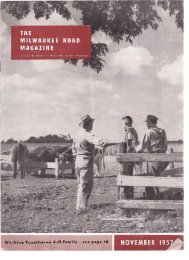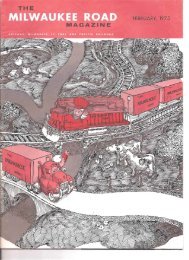July-August, 1969 - Milwaukee Road Archive
July-August, 1969 - Milwaukee Road Archive
July-August, 1969 - Milwaukee Road Archive
You also want an ePaper? Increase the reach of your titles
YUMPU automatically turns print PDFs into web optimized ePapers that Google loves.
An early picture of a rowboat fleet cruising through the Upper Dells. (Photo by H. H. Bennett)<br />
The Wisconsin Dells - A Tourist Attraction for 100 Years<br />
The opening of the <strong>1969</strong> vacation season<br />
marked the beginning of the second century<br />
of tourism at the Wisconsin Dells,<br />
the popular Midwestern recreation area<br />
served by the <strong>Milwaukee</strong> <strong>Road</strong>.<br />
According to local history, the industry<br />
was "born" in 1869 when the operators<br />
of a vacation resort known as the<br />
Tanner House hitched up a horse and<br />
buggy and drove their guests to the head<br />
of the Dells for a rowboat ride seven<br />
miles downriver through the gorges of<br />
the majestic Wisconsin. Along the way<br />
the sightseers were fascinated by· the<br />
panorama of towering cliffs, table rocks<br />
and wild ravines that tell the story of an<br />
old detour while primeval forces carved<br />
out the present river bed.<br />
At that time the town was named Kilbourn<br />
City as a tribute to Byron Kilbourn,<br />
president of the La Crosse & <strong>Milwaukee</strong><br />
Railroad (a predecessor line of the <strong>Milwaukee</strong><br />
<strong>Road</strong>), which had built north<br />
and crossed the Wisconsin at this point<br />
in 1857. The name endured until 1931,<br />
when it was changed to the more descriptive<br />
Wisconsin Dells.<br />
Before the influx of white settlers, the<br />
region was the home of the Winnebago<br />
tribe, and the area abounded with Indian<br />
lore. Legend has it that the Dells were<br />
formed by a giant serpent that battered<br />
14<br />
its way through subterreanean rock, leaving<br />
a massive trail of unique geological<br />
formations.<br />
The catalyst of tourism in this primitive<br />
wilderness-the first person to appreciate<br />
its potential as a scenic empirewas<br />
a young <strong>Milwaukee</strong> <strong>Road</strong> telegrapher,<br />
George Humphrey Crandall. Upon<br />
arriving in Kilbourn City, Crandall<br />
courted and married a daughter of H. H.<br />
Bennett, a pioneer in scenic photography<br />
who had established a studio there in<br />
The launch Chief of<br />
the modern sightseeing<br />
fleet passes Chimney<br />
Rock in the Upper<br />
Dells. Today's<br />
fleet consists of 22<br />
launches ranging in<br />
passenger capacity<br />
from 80 to 300 persons.<br />
1865. (The Bennett studio is reputed to<br />
be the oldest in the United States.)<br />
Abetted by his father-in-law, Crandall<br />
obtained from the Southern Wisconsin<br />
Power Company a long-range lease on<br />
numerous tracts of land adjoining the<br />
river. He also took over the company's<br />
river equipment, including a stern-wheel<br />
passenger steamer. Gradually he began<br />
acquiring other property along the river<br />
for the purpose of preserving the virgin<br />
timber lining its banks. Later, as his<br />
The <strong>Milwaukee</strong> <strong>Road</strong> Magazine



